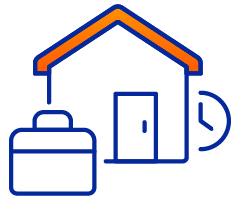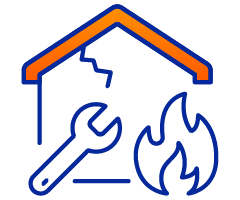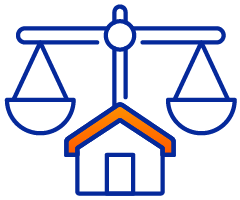Start Here
Homepage Bottom Form
We will get back to you as soon as possible.
Please try again later.
Safe Fire Cleanup Guide for Homeowners
🧱 Fire Restoration Contractor Vetting Checklist
Created by House Fire Solutions – Trusted Guidance for Fire Recovery & Rebuilding
Hiring the right contractor after a fire can make or break your recovery.
A qualified, trustworthy professional will help restore your home safely, on budget, and in compliance with your insurance claim.
This checklist walks you through every step of evaluating, verifying, and choosing a contractor —
before you sign anything.
🔹 1. Verify Legitimacy & Licensing
☐ Confirm the contractor holds a
valid state license for fire restoration or general contracting.
☐ Ask for the
license number and verify it online with your state’s licensing board.
☐ Ensure they have a
local business address, not a P.O. box or temporary setup.
☐ Check that they are registered to do business in your city or county.
☐ Request a copy of their
driver’s license or company ID for verification.
☐ Ask how long they’ve been in business (look for 5+ years of experience minimum).
☐ Verify that they are not operating under a
different or new company name (a red flag for past issues).
☐ Search for any
complaints or disciplinary actions against them through your state board or BBB.
💡 Tip: Beware of contractors who show up uninvited after a fire — these “storm chasers” often disappear after taking payment.
🔹 2. Confirm Insurance Coverage
☐ Request a
Certificate of Insurance (COI) with your name listed as a certificate holder.
☐ Verify
General Liability Insurance — covers property damage or accidents.
☐ Verify
Workers’ Compensation Insurance — protects you if workers are injured onsite.
☐ Ensure coverage is
active and not expired.
☐ Call the insurance provider to confirm validity.
☐ Check that policy limits are adequate for your property’s size and value.
💡 Tip: Never accept verbal proof of insurance — always request official documents.
🔹 3. Verify Fire Restoration Credentials
☐ Ask if the company specializes in
fire, smoke, and water restoration.
☐ Request certifications from organizations like:
- IICRC (Institute of Inspection Cleaning & Restoration Certification)
- RIA (Restoration Industry Association)
☐ Confirm team members are trained in hazardous material handling (soot, asbestos, etc.)
☐ Ensure they use industrial-grade HEPA filtration and drying equipment.
☐ Ask for before-and-after project photos of fire-damaged homes.
☐ Check that they follow EPA and OSHA safety standards.
☐ Verify that subcontractors (if any) are also certified.
💡 Tip: A general contractor without fire restoration credentials may not meet your insurer’s requirements.
🔹 4. Ask About Experience & References
☐ Request
three local references from homeowners who had similar fire restoration work done.
☐ Call each reference and ask:
- Was the project completed on time?
- Did costs match the estimate?
- Were you satisfied with communication and cleanup?
☐ Ask for project examples that match your type of damage (kitchen, attic, full rebuild).
☐ Check online reviews (Google, BBB, Yelp, Facebook).
☐ Look for consistent high ratings over several years, not just recent reviews.
💡 Tip: Be cautious if the contractor can’t provide verifiable references or project photos.
🔹 5. Review the Estimate Carefully
☐ Obtain at least
three written estimates from different companies.
☐ Ensure estimates include:
- Detailed itemization of materials, labor, and permits
- Specific repair and replacement descriptions
- Timeline for completion
- Cleanup and debris removal costs
☐ Confirm that all line items are written — no vague phrases like “as needed.”
☐ Ask if sales tax and disposal fees are included.
☐ Review estimates with your insurance adjuster or public adjuster before approving.
☐ Get all changes to the estimate in writing.
💡 Tip: Avoid contractors who won’t provide detailed, written estimates.
🔹 6. Confirm Contract Details
☐ Read the
entire contract — including small print and back pages.
☐ Verify that all work descriptions match the approved estimate.
☐ Check for clear
start and completion dates.
☐ Review the
payment schedule — never pay the full amount upfront.
☐ Ensure a
final payment is due only after you sign off on the completed work.
☐ Confirm
who is responsible for permits, inspections, and debris removal.
☐ Require that all
change orders must be signed by both parties.
☐ Ask about
warranty coverage for materials and workmanship.
☐ Avoid any
arbitration clauses that prevent you from legal recourse.
💡 Tip: Don’t sign “Authorization to Proceed” or “Assignment of Benefits” (AOB) forms unless fully explained by your insurer.
🔹 7. Evaluate Communication & Professionalism
☐ Does the contractor respond promptly to calls or emails?
☐ Do they provide written updates and progress reports?
☐ Are they transparent about challenges or delays?
☐ Is their office staff courteous and organized?
☐ Are they willing to explain processes and timelines clearly?
☐ Do they provide emergency contact numbers for urgent issues?
☐ Are they available for post-project support or warranty service?
💡 Tip: Good communication is a sign of professionalism — silence or confusion is a warning sign.
🔹 8. Watch for Red Flags
🚫 Unwilling to provide license or insurance proof
🚫 Requests large cash deposits or full payment upfront
🚫 Claims “We’ll handle your insurance for you”
🚫 No physical business location or online presence
🚫 High-pressure sales tactics (“Sign today and we’ll start tomorrow”)
🚫 Unmarked vehicles or no uniforms
🚫 Refusal to provide written estimates or contracts
💡 Tip: If it sounds too good to be true — it probably is.
🔹 9. Protect Your Payments
☐ Never pay more than
10–20% upfront (depending on state law).
☐ Always pay by
check, card, or bank transfer — never cash.
☐ Keep
copies of every invoice and receipt.
☐ Ask for
lien releases from subcontractors after each payment.
☐ Hold the
final 10% until all work passes inspection.
☐ Verify that materials listed on invoices were actually used.
💡 Tip: Keep payment and invoice records in your Fire Recovery Binder for insurance reimbursement.
🔹 10. Final Quality & Safety Inspection
☐ Walk through the entire property before final payment.
☐ Verify all repairs meet
local building codes.
☐ Check that all
permits are closed and approved.
☐ Ensure
HVAC ducts, wiring, and plumbing were properly inspected.
☐ Confirm cleanup and debris removal are complete.
☐ Take
before-and-after photos for your records.
☐ Request a
final written warranty and completion certificate.
💡 Tip: A professional contractor will always invite you to a final inspection and address concerns before closing out the project.
✅ Homeowner Takeaways
✔ Always verify credentials, insurance, and references before hiring.
✔ Never sign a contract without fully understanding it.
✔ Keep documentation organized and stored safely.
✔ Use your Fire Recovery Binder or Excel checklist to track vetting progress.
✔ Trust your instincts — if a contractor makes you uncomfortable, find another.
Our Team Helps You Navigate Insurance, Restoration, and Rebuilding
It is a long established fact that a reader will be distracted by the readable content of a page when looking at its layout.

Board-Up
Our Network of Board Up Specialist Will Secure your property fast

Temp Housing
We'll Help You Find Safe Shelter while you recover

Public Adjusters
Our Network of Fire Damage Adjusters Will Fight Help for a fair insurance payout

Investors
Our Partner Specializes in Buying Fire Damaged Homes So you Can Sell your home as-is

Content Cleaning
Restore what matters most

Restoration
Bring your home back to life

Attorneys
We have a network of Protect your rights and claims

Mental Health
Support for you and your family
Want To See If We Can Help You
If you'd like to speak with us today about purchasing Social Security, Personal Injury, Workers' Compensation or Employment Law Leads.
Homepage Bottom Form
We will get back to you as soon as possible.
Please try again later.